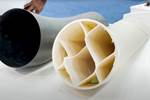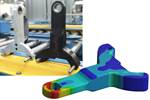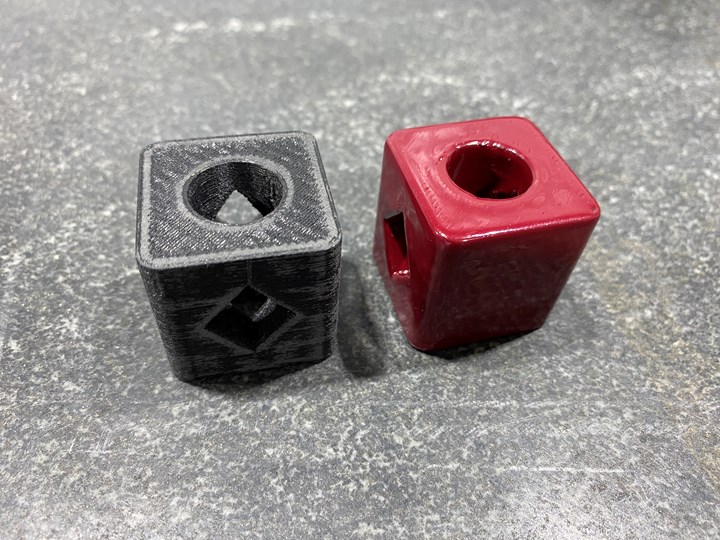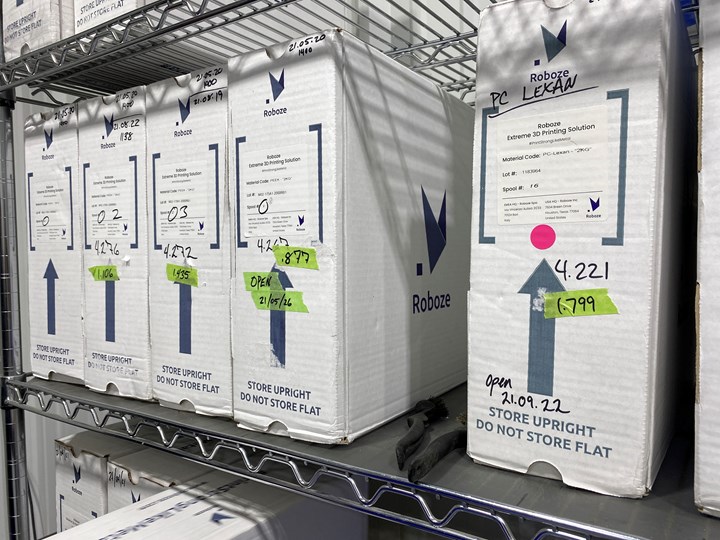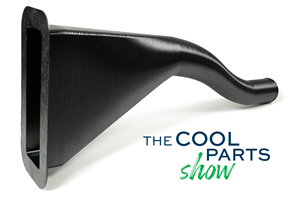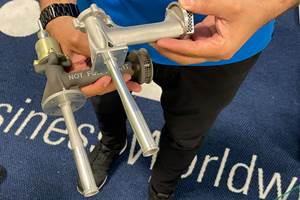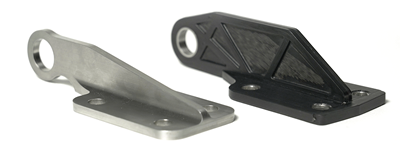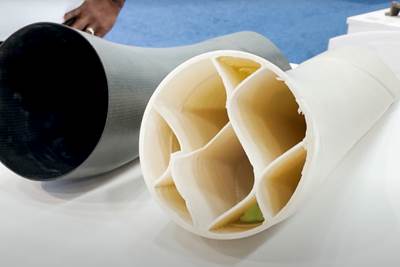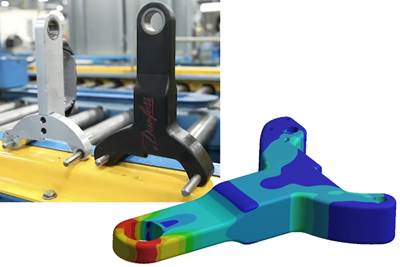As 3D printing materials advance, so do their applications. High performance polymers like PEEK and composite materials with carbon and ceramic fibers have temperature, mechanical and chemical resistances that are similar to metals — similar enough that many industries have found that their properties fit the requirements for some applications. But what are the limits of these materials? Companies are still working to figure what the boundaries are when replacing traditionally manufactured metal parts with 3D printed super polymers and composites.
In addition to making end-use parts, Werco Manufacturing makes maintenance and part task trainers for the commercial airline and defense industries. Trainers can be as small as a few parts, or as large as an airplane fuselage, and are typically made with salvaged aircraft.
Photo Credit: Werco Manuacturing
Werco Manufacturing, an aerospace and defense manufacturer in Broken Arrow, Oklahoma, is one company that’s exploring this question. In 2020, it added two Roboze Argo 500 3D printers to its manufacturing capabilities, which also include sheet metal fabrication, welding, CNC machining and parts finishing. The majority of its work (about 70%) comes from the military, while the remainder is for commercial airlines.
Not only is Werco making end use parts for aerospace and defense, it also specializes in making aircraft training devices (or “trainers”) that are used in maintenance and procedural training. “We typically build trainers for everything behind the cockpit,” explains Andy Bartovick, chief operating officer at Werco. “We're not building full flight simulators. It's mainly maintenance trainers and part task trainers.” These trainers can be very large and complex (think a whole aircraft fuselage), or as simple as a few part assemblies. The customer tells Werco what tasks the end product needs to include and whether it needs to be low, medium or high fidelity, and then the shop works within those requirements to build the trainer.
High-fidelity trainers need to be as close to the actual aircraft as possible, so they’re often made using salvaged aircraft parts. But, according to Bartovick, aircraft salvage is getting harder and harder to find. On the military side, “a big part of it is the Air Force is extending the lifecycles of some of its planes,” he explains. “There are two or three planes out now that were supposed to retire either coming up soon or a few years past, and they've pushed them out 10, 15 years or more.” These aircraft are being used until they can’t fly any more, and before they’re deemed to go to salvage, the military will often take the usable parts and run them through the MRO process to get them back into the air. What’s sent to salvage is often unusable. Salvage is similarly difficult to come by for commercial aircraft as well — the market for it is volatile and moves really fast. “There are just so many risks and extra lead time when you deal with salvage,” he says.
3D printing seemed like a good fit for replacing salvaged parts because of the low-volume and one-off nature of the work. “It saves time because we're not taking the salvage, bringing it in, modifying it and then turning it into what we need it to be,” Bartovick says. “On day one we can start the engineering process and making the actual part.”
With salvaged aircraft parts becoming more difficult to acquire, Werco added two Roboze Argo 500 3D printers to make these parts from scratch. These printers are designed to work with high-performance materials like PEEK and carbon PEEK, which enable the shop to produce nonmetal parts that function like metal ones.
The company wasn’t ready to invest in a metal 3D printing system, but it needed a way to produce parts that were similar to metal. The functional parts in a trainer can go through a good amount of wear and tear, Bartovick notes. “The people that are using it are training and new to the tasks, so you’ve got to assume they're going to mess up and force something when they shouldn't force it.” Traditional polymers aren’t durable enough for many of these applications, but high-performance polymers such as PEEK and composites such as carbon PEEK are. “Filaments in really high performance polymers allow us to get those areas to where they can function almost just like a real aircraft,” he explains. These materials are what sold Werco on the Roboze machines — it hoped that high performance materials would differentiate its 3D printing capabilities from other service providers. The Argo 500 is specially designed to work with these high-performance materials. Its features include a heated build chamber and build plate, as well as filament drying and preheating systems to ensure users can print super polymers and composites accurately and consistently.
Harder, Better, Faster, Stronger
Werco has found a number of benefits to working with stronger, high performance materials like PEEK and carbon PEEK. For one, the carbon PEEK parts can be machined. “The fact that we can print a part and then put it in one of our lathes or our mills and run a cutting tool on it, is just huge,” Bartovick says. Compared to hand sanding, machining is a faster and easier way to finish parts. The shop also machines 3D printed parts to remove supports and tighten the tolerances so they are more in the realm of a salvaged part. According to Bartovick, as long as the 3D printed part can be fixtured and is solid (or close to solid), machining it is similar to machining a metal part (although he notes that the carbon PEEK is so tough that it tears up cutting tools).
Carbon PEEK is stronger and more heat resistant than traditional polymers such as ABS, allowing these parts to be machined like metal. Carbon PEEK can also be powder coated due to its higher heat tolerances and its ability to hold a negative charge.
These materials are also easier to paint and powder coat than traditional polymer parts. Bartovick says that a lot of the 3D printed parts that go into the trainers are painted. “On the trainer side, most of the parts that we do actually end up getting painted,” he says. “So we can build a large part in multiple pieces, bond them together, do filler on them and then paint them and then you'd never know it was multiple parts.” Bartovick says that the painting process for 3D printed parts is the same as metal parts, but the shop needs to be careful when putting traditional materials such as ABS and PLA into a heated paint booth. PEEK and carbon PEEK’s heat tolerances are high enough to handle the paint booth’s temperatures without any issues. The high heat tolerances, along with its ability to hold a negative charge, also allow carbon PEEK to be powder coated.
Lessons Learned
Now that Werco has had the machines for almost two years, Bartovick says it has learned some important lessons about 3D printing high-performance materials. First, the shop had to realize that just because it can print these materials doesn’t mean it always should. Initially, it quoted all 3D printed parts using the high performance materials, and its prices reflected that. Eventually it recognized that these materials aren’t necessary for all applications. “We've kind of come back down to earth a little bit and brought in standard ABS and PLA,” he says. The fact that the Argo can print both traditional and high-performance filaments is a bonus, and because the machine doesn’t have a closed materials ecosystem, the shop can get standard filaments from a number of sources. Bartovick estimates that 60% of the company’s 3D printing work is carbon PEEK, with the remaining 40% being split evenly between regular PEEK and ABS.
High performance filament is expensive, so Werco gages its part runs by how much filament is left on a roll. The operator checks the weight of the roll to ensure it isn’t too small, but also that the run won’t burn down the roll to where there’s still filament left, but not enough to make a part.
With the majority of its parts being printed in high-performance materials, Werco has also learned to organize its production by how much material is left on a spool. “The filament is not cheap,” Bartovick says. “So you don't want to burn a roll down to where it doesn't have enough filament left for another part run, but there are still a few dollars left on the roll. We definitely make an effort to gage part runs by how much filament is on the roll.” He notes that leaving say, 20 feet of carbon PEEK filament on one roll isn’t the end of the world, but these costs can add up over time. This process started off as a way to ensure that the spool of filament wasn’t too small for the print, but it has had the added benefit of enabling the operator to check how much filament will be left after the print. Other solutions to reduce material costs are also in work. Bartovick says that Roboze is working on a software update that will allow users to switch out a filament roll mid-print without compromising the parts, and the shop is working to find a way to fuse smaller pieces of filament together and re-spool them.
Translating Success
Between end-use parts, internal tooling projects and prototyping/test parts, Bartovick says that Werco is running its two 3D printers just about every day. It’s looking at getting a Roboze Argo 1000 (which has a build volume of 1,000 × 1,000 × 1,000 mm, as opposed to the Argo 500’s 500 × 500 × 500 mm envelope) to print larger parts. This would free the shop from having to print smaller pieces and then assemble and paint them to make larger parts. It’s also looking forward to working with new high-performance materials from Roboze, including Helios PEEK 2005, which is reinforced with chopped ceramic fibers. Bartovick says that this material will have higher thermal properties and will likely require less postprocessing due to its better surface finish.
The company hopes to translate its success in 3D printing parts for aircraft trainers into 3D printing parts for actual aircraft. Bartovick believes that that the carbon PEEK especially, with its mechanical, heat and chemical resistance, could be used in place of metal parts. These parts could be machined to ensure tight tolerances and painted or coated like a metal part. He also notes that carbon PEEK parts would require less postprocessing than a 3D printed metal part.
Werco has seen a need for low-volume and one-off aerospace parts. “Tinker Air Force Base in Oklahoma City just presented a list of spare parts — it's a 70 page Excel spreadsheet of parts that they’re finding difficult to get for number of reasons,” Bartovick explains. “There either were not enough suppliers or they're just too complicated. So we're looking at that list saying, well, we can 3D print some of these items, and it should hold up to the specs.” But the problem, he says, is that there’s not yet a realistic path for getting alternate parts approved. Werco is currently collaborating with other companies on this issue. “We're getting close, it's just that process of pushing it through and getting it tested,” he says. “At the end of the day, it may not work but at least you've got that open channel to find out fairly quickly, and then you can move on to the next part and see if you can make that work.”
Related Content
Aircraft Ducts 3D Printed in Composite Instead of Metal: The Cool Parts Show #68
Eaton’s new reinforced PEKK, tailored to aircraft applications, provides a cheaper and faster way to make ducts compared to formed aluminum.
Read MoreThis Drone Bird with 3D Printed Parts Mimics a Peregrine Falcon: The Cool Parts Show #66
The Drone Bird Company has developed aircraft that mimic birds of prey to scare off problem birds. The drones feature 3D printed fuselages made by Parts on Demand from ALM materials.
Read MoreAt General Atomics, Do Unmanned Aerial Systems Reveal the Future of Aircraft Manufacturing?
The maker of the Predator and SkyGuardian remote aircraft can implement additive manufacturing more rapidly and widely than the makers of other types of planes. The role of 3D printing in current and future UAS components hints at how far AM can go to save cost and time in aircraft production and design.
Read MoreQualification Today, Better Aircraft Tomorrow — Eaton’s Additive Manufacturing Strategy
The case for additive has been made, Eaton says. Now, the company is taking on qualification costs so it can convert aircraft parts made through casting to AM. The investment today will speed qualification of the 3D printed parts of the future, allowing design engineers to fully explore additive’s freedoms.
Read MoreRead Next
3D Printed Composite Bracket Versus Machined Steel: The Cool Parts Show #41
Can a 3D printed composite bracket work as well as one machined from steel? Can it also be faster to make and cheaper to produce? In this episode of The Cool Parts Show we explore a new way of manufacturing a bracket for a helicopter door hinge, and similar small parts today made from metal.
Read More3D Printing Reduces Time, Cost of Building Molds for Composites
Massivit 3D’s cast-in-motion technology uses a 3D printed gel to expedite production and lower costs associated with making molds for large, fiber-reinforced composite parts.
Read MoreWorkflow Validates 3D-Printed Composite Part Performance
A new workflow connecting 3D printing data with finite element analysis (FEA) enables simulations of fiber-reinforced 3D-printed parts that can predict mechanical and structural performance.
Read More



